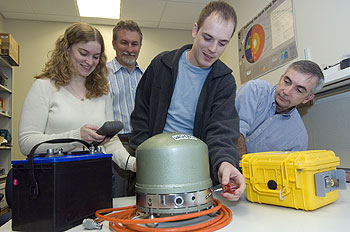A team of WUSTL seismologists — like members of the mythical starship Enterprise — will soon boldly go where no man has gone before.

The team, led by Douglas A. Wiens, Ph.D., professor of earth and planetary sciences in Arts & Sciences, will go to remote regions of Antarctica after Thanksgiving to place seismographs in both east and west Antarctica. The goal is to learn about the earth beneath the ice and glean information about glaciers, mountains and ice streams.
The location of their field camp, called AGAP-South, never before has been visited by humans, and the entire region of Antarctica has only been traversed twice — by a Russian team 50 years ago and by a Chinese team last year.
And up until now, no woman has seen these parts of Antarctica, either. Wiens’ graduate student, Moira Pyle, will hold the distinction of being the first woman to set foot there.
The projects, funded by the National Science Foundation (NSF) are WUSTL’s contribution to a celebration of the current International Polar Year (IPY), 125 years after the first IPY (1882), 75 years after IPY 2 (1932) and 50 years after the first International Geophysical Year. The research period for the celebration is actually two years, March 1, 2007, through March 31, 2009.
Wiens and the group will install 10 seismographs each in the east and west parts of Antarctica, with an additional 20 instruments to be placed next year in a return trip. Members of the group will spend between one to two months in Antarctica.
It will be summer in Antarctica, with temperatures maxing out at 30 below zero Fahrenheit. The researchers will stay in a heated tent at their base camp 400 miles from the nearest civilization, South Pole base, and about 3,000 miles from New Zealand. They will wear sturdy boots, snow pants and parkas and cover their faces with masks as the potential for frostbite to exposed skin is very high.
While two of the five will stay at base camp to prepare for the next day, three will be transported as far as 300 miles away to install the seismographs.
The vehicle will be a stout aircraft made in the 1950s called a Twin Otter dual prop, sometimes referred to as a Dehavilland-6. There are, of course, no runways on ice, so the aircraft is equipped with skis. They will have a Canadian pilot who will have access to a spreadsheet denoting various caches of fuel — barrels weighing up to 300 pounds or more — spread throughout the Antarctic.
The effects of the ice and sun will tell the researchers they’re not in Missouri anymore.
“The surface of the Antarctic looks essentially like a snow-covered western Kansas, but mountains lurk beneath two miles of ice,” said Wiens, who has researched the Antarctic since the 1990s and installed the largest-ever array of seismographs, 43, earlier this decade. “You see nothing but a vast flat sea of white under constant sunshine. It’s really eerie out there.
“In terms of the east, we have no idea what’s beneath the ice,” Wiens said. “No one has even taken any rock samples. It’s thought that when the Earth’s climate started to cool millions of years ago, the first glaciers in the world formed in these mountains. But we really don’t know if the mountains were there at the time the glaciers formed.”
Analysis of seismic waves could reveal how old the mountains are and their relationship to the formation of glaciers.
“One of the things we should be able to determine is what’s causing the elevation of the mountains,” he said. “It’s probably either due to a thick crust or hot temperatures in the mantle. If it’s hot temperatures in the mantle, the mantle can’t stay hot for billions of years, so that would tell us that it’s due to fairly recent activity. But if it’s thick crust, we can speculate that it was formed a long time ago.”
In west Antarctica, global warming is a concern. Wiens said that simulations show that the ice sheet in west Antarctica could fall apart if the Earth warms up, flooding coastal cities around the world.
Ice streams, which are like rivers of ice as much as 80 miles wide, are a study focus. Wiens said some studies over the past 40 years show some ice streams speeding up and others are slowing down.
Seismographs can detect sudden motion of the ice streams to help understand what controls their motion. Also, the rate of motion of the ice streams is related to the conditions of the rocks beneath.
“We need to know how hot the mantle is,” Wiens said. “If it’s really hot, the ice will flow easier. If it’s really cold, it won’t flow at all.”
Since this work is part of the IPY, the WUSTL group will not be the only researchers working on these projects. Chinese, French, Japanese and Italian seismologists will be in Antarctica, as will be Americans from Ohio State University, Columbia University and Penn State University, among others.
A collaboration with Ohio State combines the seismic data with global positioning system data in one coordinated project called Polenet. “Their data complements ours in understanding how the loss of ice is related to uplift of the land,” Wiens said.
Rounding out Wiens’ research team are graduate students Mitchell Barklage and David Heeszel, a newbie to Antarctica. Antarctica veteran Patrick Shore, a lecturer and computer specialist in earth and planetary sciences, will go as well and has accompanied Wiens on many different seismic expeditions.
One important thing Wiens will stress to the group is sleep.
“You have to be careful that you keep sleeping,” Wiens said. “When you first get there, and it’s light all the time, you get jazzed up and want to keep working.
“Your body doesn’t really tell you to sleep. You get tired, but your eyes are telling you the sun is still out,” Wiens said.